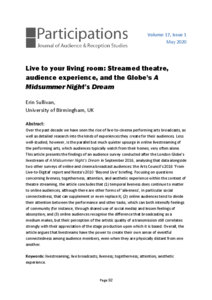
Over the past decade we have seen the rise of live-to-cinema performing arts broadcasts, as well as detailed research into the kinds of experiences they create for their audiences. Less well-studied, however, is the parallel but much quieter upsurge in online livestreaming of the performing arts, which audiences typically watch from their homes, very often alone. This article presents the findings of an audience survey conducted after the London Globe’s livestream of A Midsummer Night’s Dream in September 2016, analysing that data alongside two other surveys of online and cinema broadcast audiences: the Arts Council’s 2016 ‘From Live-to-Digital’ report and Nesta’s 2010 ‘Beyond Live’ briefing.
Focusing on questions concerning liveness, togetherness, attention, and aesthetic experience within the context of theatre streaming, the article concludes that (1) temporal liveness does continue to matter to online audiences, although there are other forms of ‘aliveness’, in particular social connectedness, that can supplement or even replace it; (2) online audiences tend to divide their attention between the performance and other tasks, which can both intensify feelings of community (for instance, through shared use of social media) and lessen feelings of absorption; and (3) online audiences recognise the difference that broadcasting as a medium makes, but their perception of the artistic quality of a transmission still correlates strongly with their appreciation of the stage production upon which it is based. Overall, the article argues that livestreams have the power to create their own sense of eventful connectedness among audience members, even when they are physically distant from one another.
Source: Article Abstract
